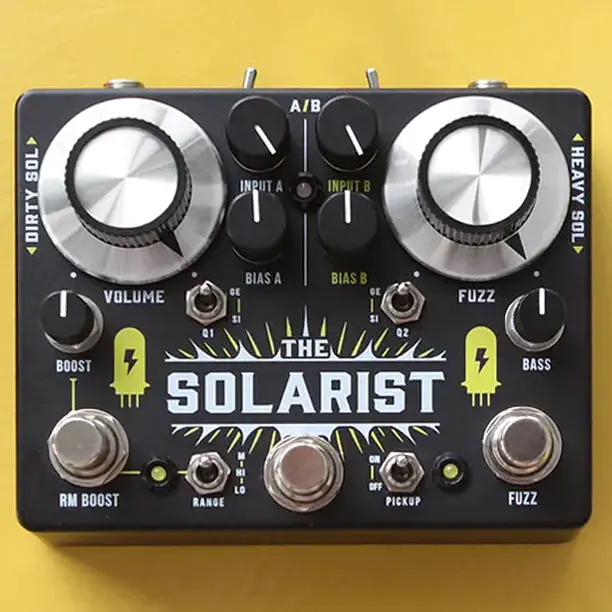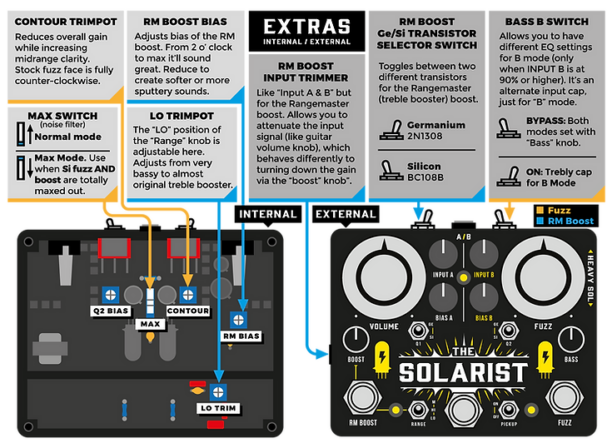
With two channels based on the venerable Fuzz Face and Rangemaster, the Palmer The Solarist is a bona fide fuzz + boost on steroids.
The pedal offers 3 clipping options per channel: on the Fuzz side you can choose between a pair of Germanium diodes (GT404B transistor), Silicon ones (NTE123), or a mix of both; on the treblebooster side, the options are also Germanium, Silicon and a mix of the two, but with different circuitry (2N1308 and BC108B transistors, respectively).
A host of extra controls allow you to extract a heck of a lot of tones out of this pedal – let’s check them out.
Besides the expected/straightforward controls (big Fuzz and Volume knobs, separate footswitches for each channel,Boost Level knob for the Rangemaster and Bass knob for the Fuzz Face), we find here a fair amount of other stuff whose function is not immediately obvious:
- on the boost’s side there’s a 3-way Range toggle that delivers original (trebly) EQ, a more mid-range option, and a full range/bassier one.
- on the fuzz ‘s side, there’s a 2-way Pickup Simulator switch which helps with compatibility with other pedals by simulating the load of a guitar pickup, allowing you to place the Solarist anywhere in your signal chain.
However, the most intriguing control of all is the third a/b footswitch, the one in the center. It brings extra versatility to the pedal, toggling between 2 the sets of “Input” and “Bias” settings (configurable through those four smaller knobs in the center-top of the pedal, allowing you to create 2 different tones and easily access them during the performance.
- The Bias knobs changes the voltage of the fuzz circuit, affecting its character and texture (normal voltage at 12 O’Clock).
- The Input knobs act as if you rolled down your guitar volume, softening the saturation.
So all in all through the three footswitches you can get a lot of different preset tones at your toe tips:
- Rangemaster Channel only, Input/Bias preset A
- Rangemaster Channel only, Input/Bias preset B
- Fuzz Face Channel only, Input/Bias preset A
- Fuzz Face Channel only, Input/Bias preset A
- Both Channel using their Input/Bias A preset
- Both Channel using their Input/Bias B preset
Oh and there are a series of internal controls that allow you to fine boost several aspects of the circuits, here’s a summary directly from the builder:
Check out how it sounds in the video below, we added the Solarist to our article about the best crazy, weird, and unusual fuzz pedals.
Palmer The Solarist, Builder’s Notes
The Swiss Army Fuzz Face and Rangemaster combo.
For the discerning Fuzz Face and Rangemaster player looking for a wide variety of sweet sounds at your feet. For the fuzz, toggle between a pair of germanium GT404B (BART) transistors, a pair of NTE123 silicon transistors, or a mix of both. For the Rangemaster, toggle between a germanium 2N1308 transistor or a silicon BC108B.
The GT404B are the NPN version of the “BART” transistors. The NTE123 are the silicon used in the Texas Square Face. The Rangemaster Boost uses a 2N1308 germanium transistor.
Why 3 Footswitches? Right is ‘Fuzz’, left is ‘Boost’ (Rangemaster treble booster). The A/B footswitch in the middle brings versatility to a new level. It toggles between 2 sets of “Input” and “Bias” knobs, so you can create 2 sounds which are wildly different, and toggle between them.
The Input knobs (also called “cleanup” or “trimmer”) mimic the effect of turning down your guitars volume knob – ie. the Fuzz Face cleans up when turned down).
The Bias knobs change the character and texture of the fuzz. With so many possibilities: glassy cleans, gritty overdrives, huge fuzz sounds, glitchy gated sounds…and on and on…you’ll be glad you don’t only have to choose one.
One way to look at it is this: you’ll have a 5 stage drive/fuzz at your feet (Rangemaster [RM]; Yellow Fuzz; Red Fuzz; Yellow Fuzz + RM and Red Fuzz + RM).
Bass/EQ controls: The bass knob is an input capacitor blend, a versatile EQ control. The “Range” switch for the Rangemaster (RNG) toggles between 3 modes, original (trebly), mid range and full range/bassy. You can also have different EQ settings for each (A/B) mode, with the switch on the back – it makes the B (yellow) mode use a fixed input capacitor independent of the bass knob. It’s a trebly cap right.
The Pickup Simulator allows you to place this pedal anywhere in your signal chain without affecting the sound.
Quality components: Hammond Enclosure, soft click footswitches, Lumberg jacks, WIMA caps and NOS transistors.
This is a one of a kind fuzz I built by hand…the result of years of tinkering and delving too deeply into Fuzz Face lore.
I take an ongoing interest in my pedals: If you manage to break it, I’d be more than happy to fix it for you. Also, if this isn’t the best or most versatile fuzz you’ve ever played I’d be happy to reimburse you fully.
Features
Analog Preset Footswitch
The A/B footswitch (center) brings versatility to a new level. It toggles between 2 sets of “Input” (think guitar volume knob cleanup) and “Bias” knobs, so you can create 2 wildly different sounds, and toggle between them.Selectable NOS Ge & Si Transistors
Toggle between germanium and silicon transistors at will for both the Fuzz and the Rangemaster boost. The fuzz is a pair of germanium GT404B (BART) transistors, a pair of NTE123 silicon transistors, or a mix of both. For the Rangemaster, select a germanium 2N1308 transistor or a silicon BC108B. One listen and you’ll know this is an exceptional combo.Pickup Simulator
The Pickup Simulator allows you to place this pedal anywhere in your signal chain without affecting the sound. This opens up a world of creativity when it comes to pedal order.Versatile EQ Controls
The bass knob sets the fuzz’s treble/bass level. The “Range” switch for the Rangemaster boost toggles between 3 EQ modes. You can also have different EQ settings for each (A/B) mode, with the “Bass B” switch on the back, which makes B mode a fixed treble/bass level. Internal trim pots make the EQ even more adjustable.
























